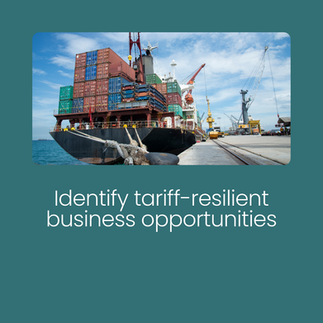When Trade Wars and Tariffs Become the New Normal: Strategies for Lasting Advantage
- IXL Center Team

- Aug 20
- 3 min read
Why This Matters Now
Escalating global trade wars, fueled by tariff hikes, protectionist policies, and disputes between major economies, are reshaping how companies think about sourcing, manufacturing, and supply chain dependencies.
What began as targeted policy actions has now become a sustained structural challenge. The April–May 2025 U.S. automotive tariffs, for example, imposed 25% duties on vehicles, parts, and critical raw materials, costs that quickly cascaded through the value chain. Similar patterns are playing out in electronics, retail, renewable energy, consumer goods, and agriculture.
The conversation has shifted from “How do we absorb tariff costs?” to “How do we redesign our global operating models to minimize exposure and maintain competitiveness?”

The Strategic Questions Every Executive Should Be Asking
Are we balancing cost, quality, and tariff exposure in our sourcing decisions?
How diversified is our supplier base across tariff-free or low-risk trade corridors?
Are our manufacturing footprints adaptable enough to respond to sudden trade policy shifts?
Do our supply chain governance models anticipate, not just react to tariff shocks?
Can localization and nearshoring become sources of competitive advantage?
Cross-Industry Market Signals
Companies are already taking bold actions to mitigate tariff pressures:
Automotive: Honda shifted Civic hybrid production from Mexico to Indiana; Rivian invested $120M in an Illinois supplier park; Volvo paused certain U.S. imports.
Consumer Electronics: Apple expanded iPhone assembly in India (14% of global output, up from <2% in 2019) and Vietnam.
Retail & Apparel: Walmart diversified procurement to Mexico and Bangladesh, while Nike relocated manufacturing to Indonesia and Central America.
Renewable Energy: Siemens Gamesa localized turbine component sourcing to align with domestic content rules.
Agriculture & Food: General Mills shifted grain sourcing to Brazil and Argentina, boosting margins despite tariff pressures.
Case Studies in Action
Our work with clients has shown that trade tensions, while disruptive, can become catalysts for long-term competitiveness if you catch signals before the others:
Automotive Supply Chain & Market Localization – Helped a global automaker integrate localized customer touchpoints and regional manufacturing to strengthen resilience against tariff-driven volatility.
Supply Chain Digitization & Regional Manufacturing – Enabled a materials science company to digitize its supply chain, accelerate regional supplier onboarding, and reduce reliance on tariff-exposed routes.
Market Diversification – Supported a petrochemical producer in entering new geographies and applications to spread revenue risk beyond tariff-vulnerable markets.
The Risk of Inaction
Organizations that fail to adapt risk:
Reduced Profitability: Tariffs and supplier surcharges raise costs faster than pricing can adjust, locking in a higher cost base.
Supply Chain Fragility: Dependence on a limited set of geographies or suppliers increases exposure to disruption; rushed re-sourcing often triggers delays and quality issues.
Missed Market Access & Incentives: Failing to meet domestic-content thresholds or local production rules forfeits subsidies, tax credits, and eligibility for strategic contracts.
Innovation Slowdown: Engineering and sourcing talent get pulled into compliance and re-qualification, starving growth programs; supplier co-development stalls as partners hedge exposure.
Operational & Financial Strain: Higher inventory buffers, premium freight, and stranded assets drain cash flow; volatility reduces investor confidence and strategic flexibility.
From Awareness to Action – How the Innovation Olympics Helps
The IXL Innovation Olympics leverages 25+ emerging global leaders drawn from top MBA, master’s, and PhD programs to co-create business concepts that help companies reimagine supply chains and market strategies even under real-world trade pressures.
Through our program, organizations can:
Get In Touch
Trade wars and tariffs aren’t temporary headwinds, they’re a reality. The winners will be those who treat disruption as a springboard, not a setback.
Let’s explore how your organization can embed fresh thinking into strategy, to turn tariff disruptions into opportunities for growth, and market leadership.

Carolina Chitiva
Growth Partner

Viola Xhafa
Senior Consultant

Ahmed El Harouchi
Associate Consultant







Comments